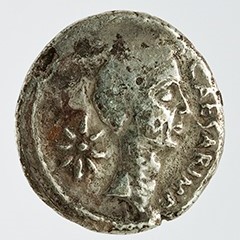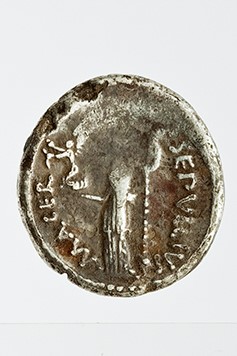Acquisition number: 1968.13
Obv.: Head of Julius Caesar r., laureate, with 8-rayed star behind. In front, CAESAR IMP(imperator) (downwards). Border of dots.
Rev.: Venus Victrix standing l., draped, holding Victory in right hand and sceptre in left. At bottom of sceptre, a star (?). At right, [P.] SEPVLLIVS (downwards); at left, MACER (upwards). Border of dots.
Title: Denarius of Julius Caesar - 1968.13
Acquisition number: 1968.13
Author or editor: Beryl Rawson
Culture or period: Roman Republic
Date: 44 BC
Material: Metal - Silver
Object type: Coins - Roman
Dimensions: 17mm (w)
Origin region or location: Italy
Origin city: Rome
Display case or on loan: 5
Keywords: Coin, denarius, Roman, Republic, Julius Caesar, Venus, Venus Victrix, Victory
Sear, D.R., Roman Coins and their Values 5 vols (London, Spink, 2000-2014) 1412; Crawford, M., Roman Republican Coinage 2 vols (Cambridge, Cambridge University Press, 2011) 480/5b and pl. LVII.2; Sear, D.R., The History and Coinage of the Roman Imperators (London, Spink, 1998) 106a;Grueber, H.A., Coins of the Roman Republic in the British Museum 3 vols (London, The Trustees of the British Museum, 1910; rev. edn London, 1970) 4165; Seaby, H.A., Roman Silver Coins (London, B.A. Seaby, 1967) 41 (Rome Jan-Feb 44BC); Sydenham, E. A. The Coinage of the Roman Republic (London, Spink, 1952; (Sanford J. Durst repr. 1976) 107.
Pandey, N., ‘Caesar's comet, the Julian star, and the invention of Augustus’, Transactions of the American Philological Association (1974-2014), 143.2 (2013), 405–449. JSTOR, www.jstor.org/stable/43830268. Gurval, R.A., ‘Caesar’s comet: the politics and poetics of an Augustan myth’. Memoirs of the American Academy in Rome, vol. 42 (1997), 39–71. Syme, R., The Roman Revolution (Oxford, Clarendon Press, 1939) 117; Taylor, L.R., PartyPolitics in the Age of Caesar (Berkeley, University of California Press, 1949) 179-81; Toynbee, J., ‘Portraits of Julius Caesar’ Greece & Rome 4 (1957) 2-9; Toynbee, J., Roman Historical Portraits (London, Thames and Hudson, 1978) 30-32.
1968.13
Denarius of Julius Caesar
3.680 g. 44 BC
Obv.: Head of Julius Caesar r., laureate, with 8-rayed star behind. In front, CAESAR IMP(imperator) (downwards). Border of dots.
Rev.: Venus Victrix standing l., draped, holding Victory in right hand and sceptre in left. At bottom of sceptre, a star (?). At right, [P.] SEPVLLIVS (downwards); at left, MACER (upwards). Border of dots.
On each side of the coin, the upper part of the type is worn.
Early in 44 BC the senate granted Caesar the right to have his portrait on coins — the first time in Roman history that such a right was granted to a living man. (Cf. Cassius Dio 44.4.) Crawford places this coin in Caesar’s lifetime, between his fourth dictatorship and his permanent dictatorship. But if the star refers to Caesar’s divinity the coin was probably minted after his death. A comet had appeared during the games which Octavian (adopted son of Caesar; the later Augustus) celebrated in July of 44 BC in honour of Caesar’s victories (Pliny Natural History 2.94; Suetonius Iulius 88), and this comet was taken by some to be the soul of Caesar on its way to the heavens. ‘Octavian as usual seized his opportunity: he had a statue of Caesar with the star above its head placed in Caesar’s temple of Venus Genetrix.’ (Earl 23.) The ‘Julian star’ occurs in Augustan literature, e.g. Horace Odes 1.12.46.
Several writers have pointed out the realism of the coin portraits of Caesar (e.g. Bieber, Carson, and Gelzer): these portraits, made in Caesar’s 56th year, show the lined and scraggy appearance of an ageing man. (For other portraits of Caesar, see J.M.C. Toynbee (1957) 2-9.)
Venus Victrix was claimed by Caesar as his special protecting deity, although Pompey had built a shrine to her in his theatre of 55 BC. Cf. on 1974.06.
Publius Sepullius Macer issued several types and denominations of coinage in 44 associated with Julius Caesar, and one type of denarius which seems to bear the portrait of Mark Antony.
Sear, D.R., Roman Coins and their Values 5 vols (London, Spink, 2000-2014) 1412; Crawford, M., Roman Republican Coinage 2 vols (Cambridge, Cambridge University Press, 2011) 480/5b and pl. LVII.2; Sear, D.R., The History and Coinage of the Roman Imperators (London, Spink, 1998) 106a;Grueber, H.A., Coins of the Roman Republic in the British Museum 3 vols (London, The Trustees of the British Museum, 1910; rev. edn London, 1970) 4165; Seaby, H.A., Roman Silver Coins (London, B.A. Seaby, 1967) 41 (Rome Jan-Feb 44BC); Sydenham, E. A. The Coinage of the Roman Republic (London, Spink, 1952; (Sanford J. Durst repr. 1976) 107.
Pandey, N., ‘Caesar's comet, the Julian star, and the invention of Augustus’, Transactions of the American Philological Association (1974-2014), 143.2 (2013), 405–449. JSTOR, www.jstor.org/stable/43830268. Gurval, R.A., ‘Caesar’s comet: the politics and poetics of an Augustan myth’. Memoirs of the American Academy in Rome, vol. 42 (1997), 39–71. Syme, R., The Roman Revolution (Oxford, Clarendon Press, 1939) 117; Taylor, L.R., PartyPolitics in the Age of Caesar (Berkeley, University of California Press, 1949) 179-81; Toynbee, J., ‘Portraits of Julius Caesar’ Greece & Rome 4 (1957) 2-9; Toynbee, J., Roman Historical Portraits (London, Thames and Hudson, 1978) 30-32.

